Leading Diapers Manufacturer
RONGPY is a factory-based manufacturer in China, specializing in disposable and reusable underpads, puppy pads, diapers, and mattress pads. We offer a wide range of sizes, absorbency levels, and custom options to suit the specific requirements of your business.
Diapers Product Lines
Adult Diapers

adult diapers

adult diapers

adult diapers
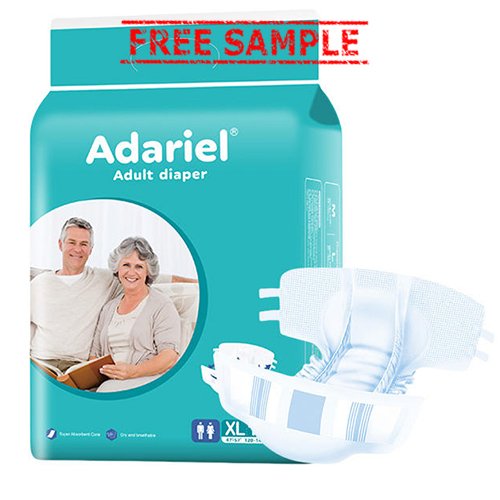
adult diapers
Baby Diapers
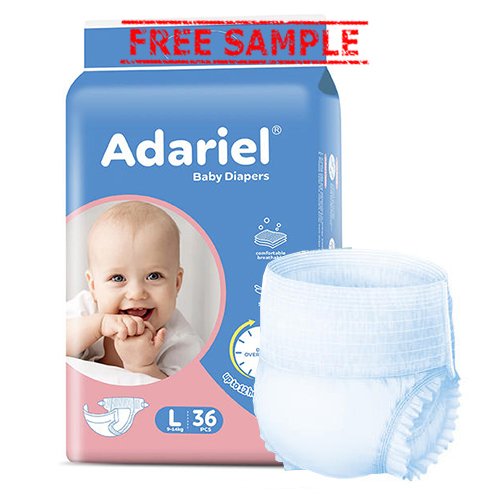
adult diapers

adult diapers

adult diapers
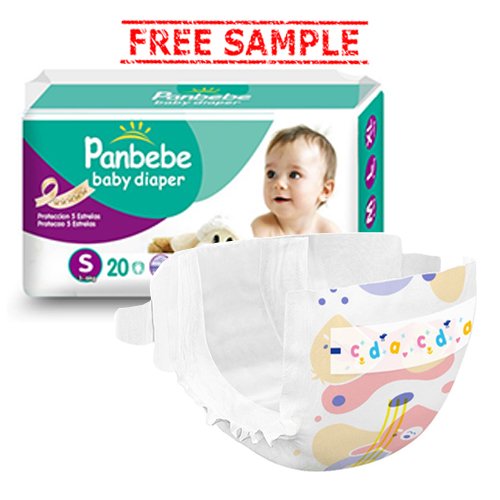
adult diapers
Can't Find the Diapers You Want?
Everything You May Want to Know About Diapers
Diapers are essential products for both babies and adults in need of absorbent solutions. As a leading diaper manufacturer, RONGPY produces high-quality diapers for various needs. Below is an exhaustive breakdown of everything you need to know about diapers, such as types, sizes, materials, usage, and more.
Table of Contents
What's A Diaper?
A diaper is a type of absorbent garment worn by babies, toddlers, and sometimes adults who are unable to control their bladder or bowels. It’s designed to catch and hold urine and feces to keep the wearer dry and comfortable. Diapers can be disposable or reusable (cloth). Disposable diapers are made with non-woven fabric that absorb moisture and are disposal after use, while cloth diapers can be washed and reusable for multiple times. They typically have elastic bands to fit snugly around the waist and legs to prevent leaks.

Types of Diapers
01 - Baby Diapers: Essential for Infant Care
Baby diapers are primarily designed for infants and toddlers to absorb urine and keep them comfortable. There are different types of baby diapers that vary in structure and application.

Disposable Baby Diapers
These are the most common type of diaper used for babies. Disposable diapers are designed for single-use, made with advanced materials that ensure excellent absorbency, hygiene, and comfort.

Cloth Diapers
Unlike disposable diapers, cloth diapers are reusable and made from natural fabrics such as cotton, bamboo, or hemp. They are typically used by eco-conscious parents who prefer a sustainable solution for their babies. Cloth diapers require regular washing but are more environmentally friendly compared to disposables. However, they may not provide the same level of absorbency as disposable diapers.

Training Pants
As toddlers grow and begin to potty train, training pants help bridge the gap between diapers and underwear. These pants are designed to be easy to pull on and off, promoting the development of independence in toddlers while still offering the protection of a diaper.
02 - Adult Diapers: Solutions for Incontinence
Adult diapers are essential for individuals who experience urinary incontinence, whether due to aging, medical conditions, or post-surgery recovery. There are several different styles to choose from.

Pull-Up Diapers
Designed to resemble regular underwear, pull-up adult diapers are easy to wear and remove, making them perfect for active adults who require light to moderate incontinence protection. They offer comfort, flexibility, and discreetness.

Tab-Style Diapers
These diapers feature adjustable tabs on either side, allowing caregivers to easily fasten or remove the diaper. Tab-style diapers are ideal for individuals who are bedridden or have limited mobility, as they offer maximum absorbency and security.

Brief-Style Diapers
Designed for people with more severe incontinence issues, brief-style adult diapers provide an extra level of absorbency and comfort. These are often used for individuals who cannot change themselves or need overnight protection.
03 - Pet Diapers: For Incontinence and Other Pet Care Needs
Pet diapers are designed specifically for pets, such as dogs, who require help managing incontinence, heat cycles, or post-surgery recovery. Pet diapers help prevent accidents and ensure comfort for pets while also providing convenience for owners.

Incontinence Pet Diapers
Similar to adult diapers, these pet diapers are designed for dogs with urinary incontinence. They provide effective leak protection, are available in various sizes, and ensure comfort for your pet.

Heat Cycle Pet Diapers
Female dogs in heat require diapers to prevent leakage of menstrual discharge. These diapers are specifically designed for comfort and fit.

Post-Surgery Diapers
Dogs recovering from surgery may need diapers to prevent accidents during the recovery period. These diapers are made with soft fabrics and adjustable waistbands to fit pets comfortably.
Diaper Sizes
Choosing the correct size is essential for the comfort and effectiveness of diapers. Diapers are sized based on weight ranges and are designed for both babies and adults.
| Type | Size | Weight Range | Usage | ||||||||
|---|---|---|---|---|---|---|---|---|---|---|---|
| Baby Diapers | Newborn (NB) | Up to 10 lbs (4.5 kg) | For newborn babies | ||||||||
| Size 1 | 8-14 lbs (3.6-6.4 kg) | For babies aged 0-3 months | |||||||||
| Size 2 | 12-18 lbs (5.4-8.2 kg) | For babies aged 3-6 months | |||||||||
| Size 3 | 16-28 lbs (7.3-12.7 kg) | For babies aged 5-12 months | |||||||||
| Size 4 | 22-37 lbs (10-16.8 kg) | For babies aged 12-24 months | |||||||||
| Size 5 | 27-35 lbs (12.2-15.9 kg) | For toddlers aged 2-3 years | |||||||||
| Size 6 | 35+ lbs (15.9+ kg) | For toddlers over 3 years | |||||||||
| Adult Diapers | Small | 18–26 inches (46–66 cm) | For adults with small waist sizes | ||||||||
| Medium | 26–34 inches (66–86 cm) | For adults with medium waist sizes | |||||||||
| Large | 34–45 inches (86–114 cm) | For adults with large waist sizes | |||||||||
| Extra Large (XL) | 45–58 inches (114–147 cm) | For adults with extra-large waist sizes | |||||||||
| Pet Diapers | Small | Up to 12 lbs (5.4 kg) | For small dog breeds or puppies | ||||||||
| Medium | 12-22 lbs (5.4-10 kg) | For medium-sized dogs | |||||||||
| Large | 22-45 lbs (10-20 kg) | For larger dogs or breeds | |||||||||
| Extra Large (XL) | 45+ lbs (20+ kg) | For extra-large dog breeds |
Materials Used in Diapers
The materials used in the manufacturing of diapers are crucial to their performance and comfort.
Top Sheet
Typically made from polypropylene or polyethylene nonwoven fabric, the top sheet is designed to be soft, breathable, and gentle on the skin.
Absorbent Core
The absorbent core is usually composed of fluff pulp combined with superabsorbent polymers (SAP). These materials ensure that urine is absorbed quickly and securely.
Backsheet
Made from polyethylene film, the backsheet is waterproof and prevents liquid from leaking out. It also provides a breathable outer layer to prevent skin irritation.
Elastic Waistbands & Leg Cuffs
Elastic waistbands ensure a snug fit, while elastic leg cuffs prevent leaks around the legs.
Wetness Indicator
Some diapers come with a color-changing line that indicates when the diaper is wet and needs to be changed.
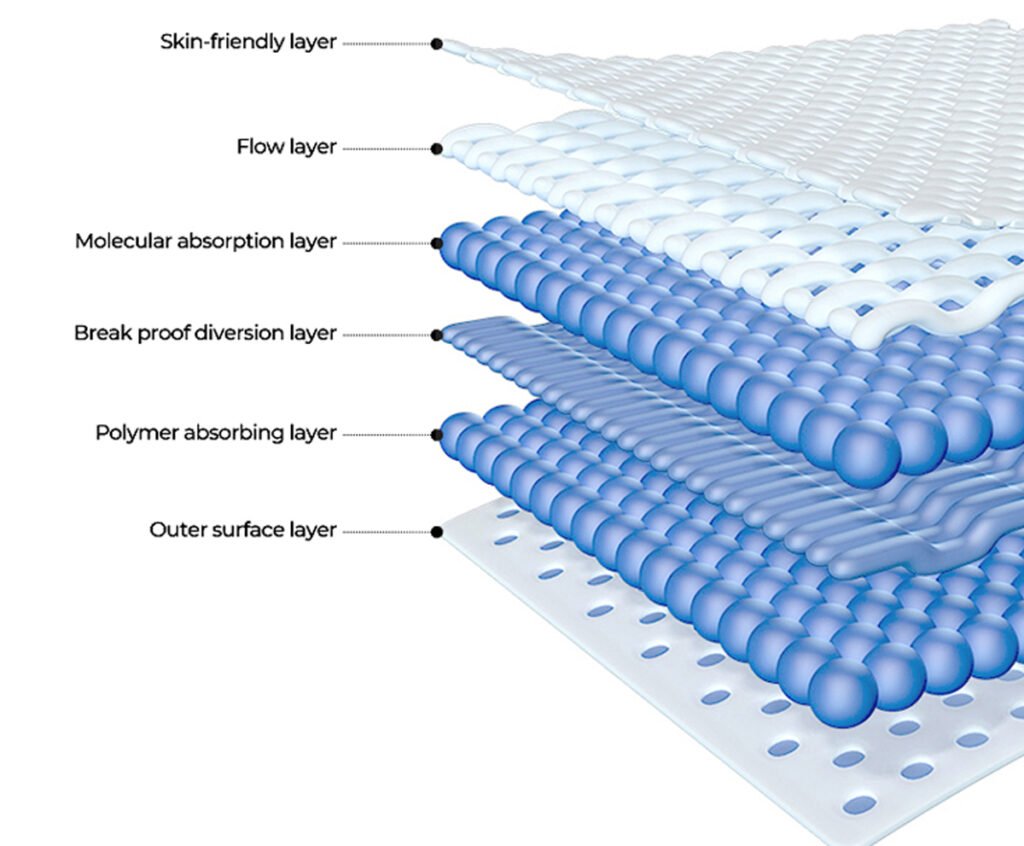
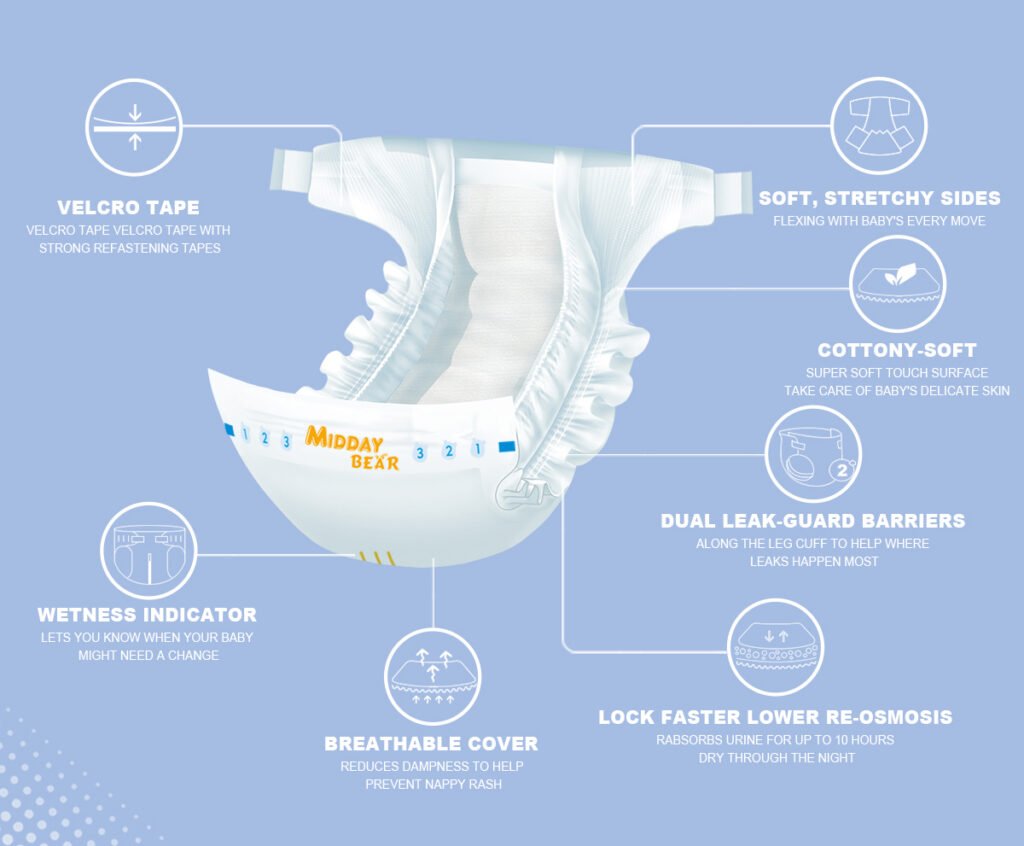
Leading Brands in the Diaper Market
The baby diaper market is highly competitive, with several brands dominating the global space. Some of the top leaders in the market include.

Pampers
One of the largest diaper brands, known for advanced absorbency and comfort.

Huggies
A close competitor to Pampers, offering soft, breathable diapers with excellent leak protection.

Luvs
One of the largest diaper brands, known for advanced absorbency and comfort.

Bambo Nature
One of the largest diaper brands, known for advanced absorbency and comfort.
Who Is the Target Market for Diapers?
Diapers are an essential product that serves a wide range of customers across different age groups and needs. The target market for diapers includes parents, caregivers, elderly individuals, healthcare facilities, pet owners, and more. Understanding the various segments within the diaper market is crucial for identifying the most profitable opportunities. Below is an overview of the primary target markets for different types of diapers
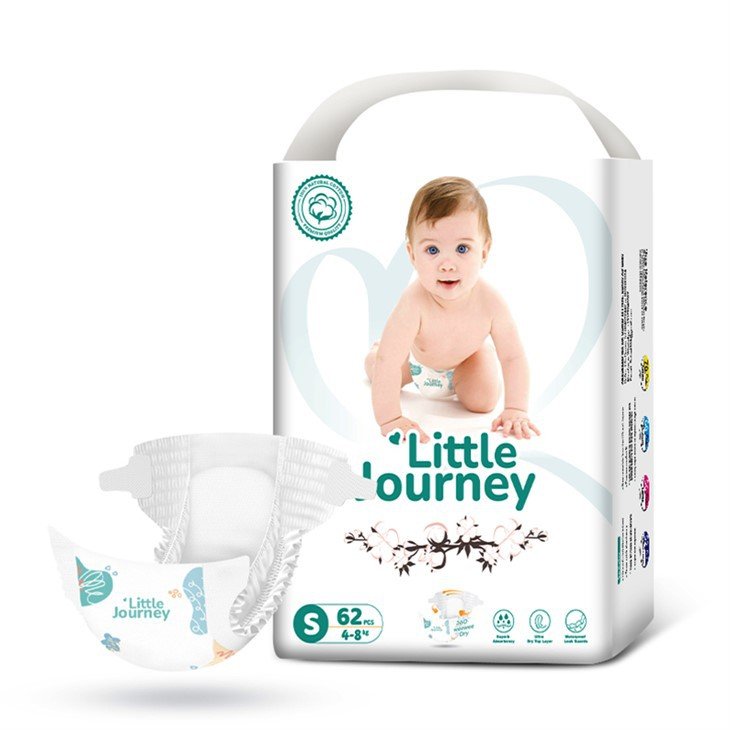
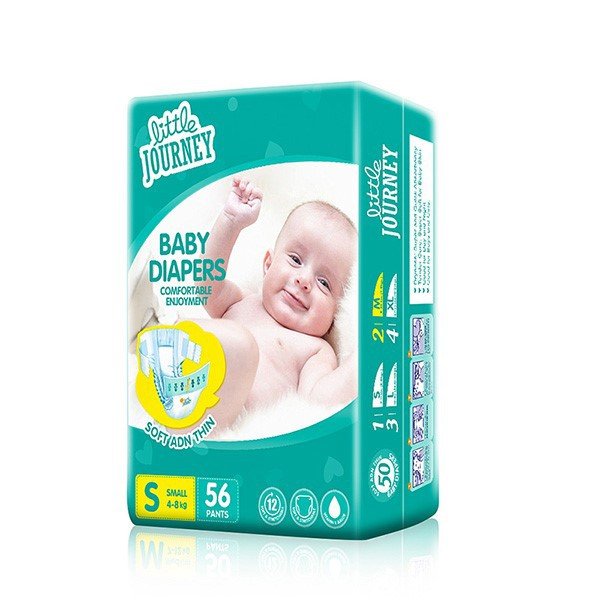
1/ Baby Diapers: Parents and Caregivers
- Primary Target Market:
Parents of infants and toddlers (especially first-time parents)
Grandparents and extended family members who help with childcare
Childcare centers and nursery schools that require large quantities of diapers for multiple children
Healthcare providers who need diapers for newborns in hospitals or pediatric care
- Key Demographics:
Age: Typically parents aged 25-40 years, with infants and toddlers (0-3 years old).
Income: Families with disposable income to spend on premium or eco-friendly products, including mid- to high-income groups.
Location: Common in both developed and developing countries, with higher demand in urban areas.
Psychographics: Parents looking for convenience, quality, and safety for their babies. There is an increasing trend toward natural, hypoallergenic, and sustainable diaper products.
- Consumer Needs:
Convenience and time-saving for busy parents.
Protection against leaks, rashes, and discomfort for babies.
Affordable bulk buying options for long-term diaper usage.
Examples:
Pampers and Huggies are two dominant diaper brands that target this market, emphasizing comfort, skin protection, and absorbency.


2/ Adult Diapers: Elderly Individuals and Healthcare Institutions
- Primary Target Market:
Elderly individuals who experience urinary incontinence or mobility issues, requiring a diaper solution for both daytime and nighttime use.
Healthcare institutions (nursing homes, hospitals, clinics) that need to provide incontinence products to elderly patients.
Caregivers who assist family members with physical limitations, post-surgery patients, or those with chronic conditions like diabetes and dementia.
- Key Demographics:
Age: Adults over 65 years, though younger individuals with certain medical conditions or disabilities may also require adult diapers.
Income: Varies from low-income to middle-class and elderly pensioners, though healthcare institutions generally purchase in bulk.
Location: Predominantly in countries with aging populations, such as Japan, North America, and parts of Europe.
Psychographics: Elderly consumers and their caregivers are often looking for practical, absorbent, and comfortable solutions that protect dignity and improve quality of life.
- Consumer Needs:
Maximum absorbency for long periods, including overnight.
Comfortable, discreet, and easy-to-use products for individuals with limited mobility.
Affordable bulk purchasing options for healthcare facilities.
- Examples:
Brands like TENA, Depend, and Always Discreet are leaders in the adult diaper market, focusing on comfort, discretion, and long-lasting absorbency.


3/ Pet Diapers: Pet Owners and Pet Care Providers
- Primary Target Market:
Pet owners, particularly those with older pets, pets recovering from surgery, or those dealing with urinary incontinence in dogs and cats.
Veterinarians and animal care providers who require pet diapers for post-surgery recovery, managing heat cycles, or other medical conditions.
Pet grooming salons and boarding facilities that may need diapers for pets staying overnight or for specific medical care.
- Key Demographics:
Age: Typically pet owners aged 25-50, including both young professionals and families with pets.
Income: Middle-income to upper-middle-income families who view pets as part of the family.
Location: Pet diaper demand is higher in urban areas with a high density of pet ownership, particularly in countries with a strong pet care culture (such as the U.S., Japan, and parts of Europe).
Psychographics: Pet owners concerned with their pets’ health, well-being, and comfort. These consumers tend to look for products that are easy to use, comfortable for their pets, and reliable for managing accidents or health issues.
- Consumer Needs:
Diapers that are absorbent, leak-proof, and gentle on a pet’s skin.
Products that are easy to use and adjust for various pet sizes and types.
Solutions for specific issues like incontinence, post-surgery care, or heat cycles.
- Examples:
Pet Parents and Vet’s Best are prominent brands in the pet diaper industry, focusing on comfort, durability, and ease of use for pets.
What Do Doctors Recommend?
When it comes to selecting diapers, doctors often emphasize certain characteristics that can help ensure both comfort and health for babies, adults, and pets. Medical professionals generally recommend diapers that prioritize skin health, breathability, absorbency, and comfort to prevent irritation and other complications. Below is a detailed breakdown of what doctors recommend for each target group.
Baby Diapers: Recommendations for Skin Health and Comfort
- Hypoallergenic and Skin-Friendly Materials:
Doctors recommend using diapers made from hypoallergenic materials that are free from harsh chemicals, fragrances, and dyes. Babies, especially newborns, have very sensitive skin, so using products with natural or organic materials (such as cotton or bamboo fibers) can reduce the risk of diaper rashes or skin irritation.
- Breathability and Ventilation:
Diapers that allow air circulation are highly recommended to reduce the chances of heat rash or diaper dermatitis. Materials with breathable back sheets, such as non-woven fabrics, allow for better air flow, helping to keep the skin cool and dry.
- Absorbency and Leak Protection:
Diapers should have high absorbency to keep moisture away from the baby’s skin. Doctors recommend diapers with Super Absorbent Polymers (SAP) and high-performance core technologies for maximum dryness. This helps reduce the risk of diaper rash, as constant wetness can lead to skin irritation.
- Frequent Diaper Changes:
Pediatricians stress the importance of frequent diaper changes to avoid prolonged exposure to urine and feces, which can lead to skin breakdown. Parents are encouraged to change diapers every 2-3 hours or whenever soiled.
- Proper Fit:
A well-fitting diaper is critical to prevent leakage and chafing. Doctors suggest choosing a diaper that fits snugly without being too tight, especially around the legs and waist. A perfect fit ensures that the diaper stays in place and does not cause discomfort or red marks.
- Doctor-Approved Brands:
Pampers Pure Protection (known for its use of organic cotton and natural ingredients)
Huggies Special Delivery (hypoallergenic and dermatologically tested)
Adult Diapers: Recommendations for Comfort and Dignity
- Skin Sensitivity and Protection:
Doctors recommend adult diapers that are made from soft, breathable materials that prevent skin irritation and help keep the skin dry. Products should have moisture-wicking properties to ensure that urine does not sit on the skin for extended periods, reducing the risk of urinary tract infections (UTIs), skin breakdown, and pressure sores.
- Absorbency and Leak Prevention:
Just like baby diapers, absorbency is a critical factor for adult diapers. Doctors recommend diapers with high absorbent capacity that can handle heavy incontinence. Some adult diapers are designed with special absorbent layers for long-lasting protection and odor control, which is essential for the dignity and comfort of elderly users.
- Fit and Comfort:
A well-fitting adult diaper is essential to avoid discomfort and skin chafing. Diapers should provide a snug yet comfortable fit around the waist and legs, preventing leakage without restricting movement. Elastic waistbands and adjustable tabs are commonly recommended for individuals with limited mobility.
- Breathable Fabrics:
Doctors often advise using adult diapers made from breathable fabrics to minimize the risk of skin irritation or pressure ulcers. Non-woven materials and micro-porous film back sheets help keep the skin dry while allowing air circulation.
- Doctor-Approved Brands:
TENA (offers advanced moisture control and skin protection)
Depend Fit-Flex (offers flexible sizing and improved comfort)
Always Discreet (for sensitive skin, with odor control)
Pet Diapers: Recommendations for Health and Hygiene
- Comfort and Mobility:
Veterinarians recommend choosing pet diapers that are comfortable and do not restrict the pet’s movement. Diapers with soft, stretchable materials are ideal for pets, as they allow them to move freely while still providing a secure fit. A proper fit is crucial to ensure that the diaper stays in place and prevents leakage.
- Breathability and Skin Protection:
Pets, especially dogs, are prone to skin rashes and infections if their skin is exposed to moisture for too long. Veterinarians recommend diapers made from breathable fabrics to allow for air circulation and prevent discomfort. Cotton-based or bamboo fiber diapers are ideal for pets with sensitive skin.
- Absorbency:
Just like baby and adult diapers, pet diapers need to be highly absorbent to handle the pet’s urine and prevent leaks. Dogs with urinary incontinence or post-surgery pets require diapers with strong absorbent layers to prevent skin irritation and maintain hygiene.
- Leakage Control:
Doctors advise selecting pet diapers that have leak guards and elastic leg bands to prevent accidents from spilling out, especially during the night or while the pet is being active.
- Disposable vs. Washable:
Depending on the pet’s needs, both disposable and washable pet diapers are recommended. Disposable diapers are ideal for short-term use or for pets that need extra care (like post-surgery), while washable diapers are better for long-term use and can be more cost-effective for owners of multiple pets.
How to Choose the Best Diaper for Your Baby?
Choosing the right diaper for your baby is a crucial decision that impacts their comfort, skin health, and overall well-being. With a wide variety of diaper brands, types, and features available, it can be overwhelming for parents to find the best option. To make an informed choice, several factors must be considered, ranging from absorbency and fit to materials and skin sensitivity. Here’s a comprehensive guide to help you choose the best diaper for your baby.
1) Absorbency: Key for Comfort and Dryness
One of the most important aspects of a diaper is its absorbency, which helps keep your baby’s skin dry and prevents irritation caused by prolonged exposure to urine.
- High Absorbent Core: Look for diapers with a super absorbent polymer (SAP) core, which draws moisture away from the skin and helps to lock it in the diaper, even after multiple wettings. This reduces the risk of diaper rash and ensures your baby stays dry for longer periods.
- Daytime vs. Overnight Diapers: If your baby tends to sleep through the night, consider overnight diapers. These usually have more absorbent layers for long-lasting dryness and help reduce leaks during sleep. During the day, you can use regular diapers that are suitable for shorter wear.
- Wetness Indicator: Some diapers come with a wetness indicator that changes color when the diaper is wet, helping you know when it’s time for a change. This feature can be especially helpful for new parents.
Tip: For newborns and younger babies, it’s important to change diapers frequently (every 2-3 hours) to keep their skin dry and prevent rashes.
2) Fit: Comfort and Leak Prevention
A good fit is critical to keeping your baby comfortable, preventing leaks, and ensuring the diaper stays in place.
- Proper Waistband and Leg Openings: Diapers should fit snugly around your baby’s waist and legs to prevent leaks, but they should not be too tight. Look for diapers with an elastic waistband and stretchable leg openings that can adapt to your baby’s body shape.
- Adjustable Tabs: Some diapers come with adjustable tabs or velcro fasteners that allow for a custom fit. These tabs ensure that the diaper stays in place, even as your baby moves around.
- Sizing: Choosing the correct diaper size is crucial. Diapers that are too small can cause discomfort, while those that are too big might lead to leaks. Refer to the weight range indicated on the diaper packaging to choose the right size for your baby.
Size Weight Range Age Range
- Newborn (NB) Up to 10 lbs (4.5 kg) Newborns and premature babies
- Size 1 8-14 lbs (3.6-6.4 kg) 0-3 months
- Size 2 12-18 lbs (5.4-8.2 kg) 3-6 months
- Size 3 16-28 lbs (7.3-12.7 kg) 5-12 months
- Size 4 22-37 lbs (10-16.8 kg) 12-24 months
- Size 5 27-35 lbs (12.2-15.9 kg) 2-3 years
- Size 6 35+ lbs (15.9+ kg) 3+ years
Tip: If your baby is between sizes, it’s often best to go with the larger size to avoid leakage, especially if the diaper is being worn overnight.
3) Skin Sensitivity: Protecting Your Baby's Skin
Babies have very delicate skin, so it’s important to choose a diaper that protects them from irritation and rash.
- Hypoallergenic Materials: If your baby has sensitive skin, look for hypoallergenic diapers that are free from fragrances, chlorine, and latex. These diapers reduce the risk of skin reactions or diaper dermatitis.
- Natural and Organic Materials: Some parents prefer diapers made with natural materials, such as organic cotton, bamboo fibers, or plant-based materials, as they are gentle on the skin and more breathable.
- No Harsh Chemicals: Ensure that the diaper is free from harmful chemicals, such as chlorine bleach, phthalates, and PVC. Many modern diapers now offer chlorine-free options that are safer for your baby’s skin and the environment.
- Breathability: Look for diapers with breathable fabrics that allow air circulation to prevent heat buildup and diaper rash. Materials like cotton-based fabrics and non-woven polypropylene are excellent choices.
Tip: Always check your baby’s skin regularly and adjust diaper brands or sizes if any irritation develops.
4) Durability and Leak Protection: Ensuring Long-Term Use
To avoid the hassle of frequent leaks and changes, choose a diaper that offers strong leak protection.
- Leak Guards and Double-Walled Design: Many diapers now feature leak guards or double walls that help contain messes. These extra layers act as barriers to prevent leaks from happening, especially during active play or sleep.
- Flexible and Stretchable Design: A diaper that can stretch comfortably across your baby’s body can ensure that it stays in place without cutting off circulation or causing discomfort. Look for soft, stretchable side panels that move with your baby.
Tip: If your baby is particularly active or sleeps on their stomach, consider diapers with extra leg cuffs or reliable elastic waistbands for better leak protection.
5) Environmental Considerations: Eco-Friendly Choices
More and more parents are looking for eco-friendly diaper options that are safer for the environment and their baby’s skin.
- Biodegradable Diapers: If you’re looking to reduce your environmental footprint, consider biodegradable diapers that use sustainable materials. These diapers break down more easily in landfills compared to traditional disposables.
- Cloth Diapers: For parents looking for a reusable option, cloth diapers are a popular choice. They are not only eco-friendly but also cost-effective in the long run. However, cloth diapers require more maintenance, including frequent washing.
- Eco-Friendly Brands: Brands like Bambo Nature and Seventh Generation produce eco-conscious diapers made from organic cotton and sustainably sourced materials.
Tip: If you choose disposable diapers, look for those with certifications like OEKO-TEX or FSC to ensure that the materials are responsibly sourced.
6) Price and Value: Finding the Right Balance
While quality is essential, you’ll also want to find diapers that offer good value for money. The cost of diapers can add up quickly, so finding a balance between cost and performance is important.
- Bulk Buying: If you find a diaper brand that works well for your baby, buying in bulk can save you money over time. Look for bulk packages or wholesale deals, especially if your baby is going through several diapers a day.
- Trial and Error: It’s common for parents to try a few different brands before settling on the one that works best for their baby. Consider purchasing smaller packs initially to see how the diaper fits and performs.
Tip: Don’t always assume the most expensive diaper is the best. Consider factors like absorbency, fit, and skin protection rather than just the price tag.
Remember, every baby is unique, so it might take a little experimentation to find the perfect diaper. Keep an eye on your baby’s skin and comfort level, and don’t hesitate to try different options until you find the right fit. Whether you’re opting for a top brand like Pampers or exploring eco-friendly alternatives, the best choice is the one that works best for both you and your baby.
